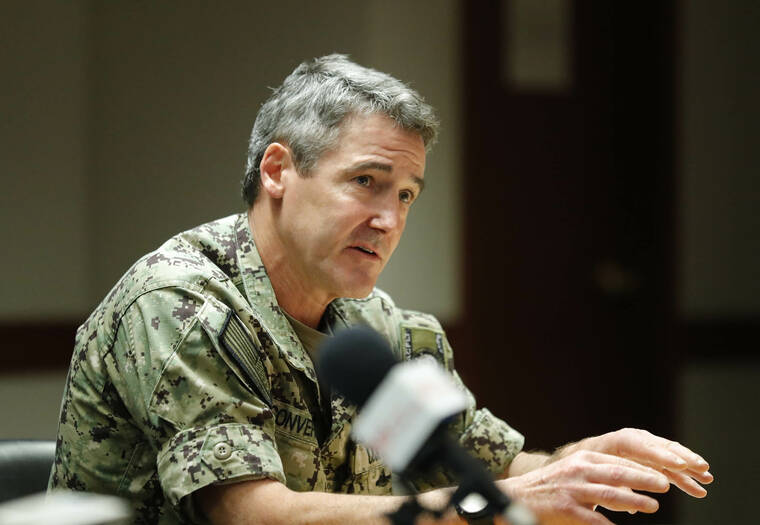Top Navy officials told state lawmakers Opens in a new tab Wednesday that they should be finished flushing their water distribution system by the end of January and that some military families who were displaced by petroleum contamination in their tap water could begin moving home as soon as late next week.
The new timeline is a significant expansion from the Navy’s assessments in early December that it could clean up its water system, which was contaminated with jet fuel in late November, in just a couple of weeks. More than 4,000 military families have moved out of their homes because of the contamination, with many living out of hotel rooms in Waikiki.
In the initial days after the water contamination was confirmed, the Navy began aggressively flushing out hydrants to clear its main distribution lines, spurring the Hawaii Department of Health to issue the Navy a cease-and-desist order.
The Navy didn’t have a permit and there were concerns that the flushing was releasing the contamination into the environment, including storm drains that lead to the ocean and streams. The Navy also asked residents to run their water and flush their toilets to get rid of the contamination, but that prompted reports of overwhelming fuel fumes.
The Navy says it is now working closely with DOH and the U.S. Environmental Protection Agency on plans to restore safe drinking water to the approximately 93,000 people who rely on its water system. Last month, officials from the agencies signed a Drinking Water Distribution System Recovery Plan, as well as a Drinking Water Sampling Plan.
“The plan includes complete flushing of the entire Navy system, from the source to the faucet, with a comprehensive series of water tests in every neighborhood to certify that drinking water meets safe drinking water standards,” Navy Rear Adm. Blake Converse told lawmakers during a joint briefing before the Senate Committee on Health and the House Committee on Health, Human Services and Homelessness.
Converse said that its main distribution lines, which carry water to neighborhoods, are being flushed and tested first. Navy officials will then be flushing individual homes, schools and businesses. About 10% of homes will be sampled to make sure the drinking water meets safe standards.
The Navy also said it will test all schools on its water system.
The staggered process means that displaced residents will be gradually given the green light to return home. Converse said that moving families back home is also contingent on DOH signing off that the water is safe.
The Health Department continues to recommend that no one on the Navy’s system drink the water.
Rep. Aaron Johanson, who represents the area around Red Hill, questioned why the Navy was testing only 10% of the homes.
“The 10%, it is a sort of statistical determination based on past events, based on academia, based on the capacity of existing labs that are in the United States and then a confidence factor that we are doing,” said Rear Adm. John Korka, commander of Naval Facilities Engineering Systems Command.
Johanson, after an awkward pause, said he was only “sort of” satisfied with the answer.
The Navy said it is also working to clean up the contamination in its Red Hill drinking water shaft, which has been isolated from its drinking water system since late November. DOH tests found the well to be contaminated with petroleum products that registered 350 times above the state’s safe environmental level.
Navy officials said they sill lacked a DOH permit and that their cleanup plan had not been finalized but is expected to be in place by next week.
“We want to be very deliberate and we want to make sure we have a unified effort,” Korka said.
He said the Navy is working to ensure that all federal and state agencies are aligned.
The Navy still needs to assemble a large granular activated-carbon system, known as a GAC, that can clean the water and is trying to figure out alternative uses for the large volume of water it will be pumping out of the shaft. Earlier this month, the Navy sent divers down into the well to skim the petroleum off the surface of the water.
The Navy also said it is soliciting a third-party contractor to do an overall assessment of the Red Hill facility, which DOH instructed as part of its emergency order that the Navy is contesting. That contract is expected to be awarded in January with work beginning in April, Converse said.
DOH representatives also were expected to attend the briefing and update lawmakers but didn’t show up. Rep. Ryan Yamane, who chairs the House Committee on Health, Human Services and Homelessness, said their absence was disappointing.
DOH spokesman Brooks Baehr said officials were “very busy dealing with multiple crises” and had conflicting schedules.




